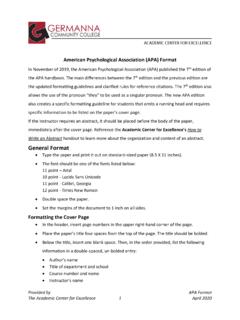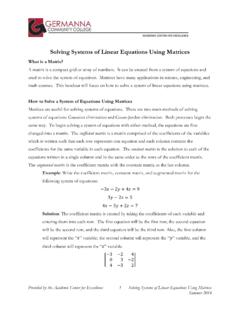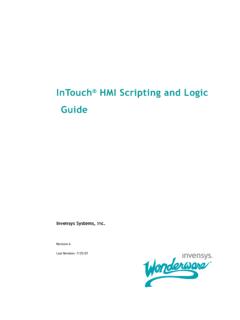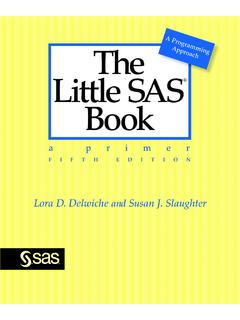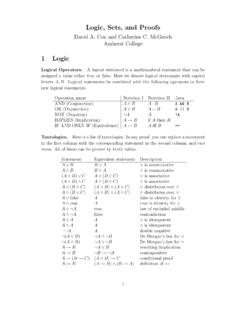Transcription of Logic and Truth Tables
1 Logic and Truth Tables What is a Truth Table? A Truth table is a tool that helps you analyze statements or arguments in order to verify whether or not they are logical, or true. There are five basic operations that you will utilize when creating a Truth table. These operations are the conjunction, disjunction, negation, conditional , and bi- conditional . These operations are also referred to as and, or, not, . if-then, and if and only if. The rules for these operations are as follows: Logic Operations And Statements These statements are true only when AND both p and q are true (as the rigorous definition of and . (conjunction) implies.). p q p q Example: I will bring both a pen AND a pencil to the tutoring T T T session. Only if I bring both is this true. T F F. F T F. F F F. OR Or Statements These statements are false only when both (disjunction) p and q are false (follows the definition of or .). p q p q Example: I will bring a pen OR a pencil to the tutoring T T T appointment.
2 Only if I don't do either is this false. T F T. F T T. F F F. NOT ~ Not Statements The not is simply the opposite or complement (negation) of its original value. p ~p Example: p = It is raining . T F ~p = It is NOT raining . F T. IF-THEN If Then Statements These statements are false only when p is ( conditional ) true and q is false (because anything can follow from a false premise.). p q p q Example: IF I am elected THEN taxes will go down.. T T T Only if I am elected and taxes don't go down is this false. T F F. F T T. F F T. Provided by the Academic Center for Excellence 1 Logic and Truth Tables Reviewed August 2017. IF AND ONLY IF If and Only If Statements These statements are true only when (bi- conditional ) both p and q have the same Truth values. Example: Taxes will go down IF AND ONLY IF I am p q p q elected.. T T T Only if I am elected and taxes go down, or I am not elected and taxes T F F do not go down is this true. F T F. F F T. Constructing Truth Tables To create a Truth table, follow these steps: 1.
3 Determine the number of variables; for n variables, create a table with 2n rows. If there are two variables (p, q), then you will need 22 or 4 rows. If there are three variables (p, q, and r), you will need 23 or 8 rows. 2. List the variable and every combination of T and F for the given variables. TWO VARIABLE THREE VARIABLE. p q p q r T T T T T. T F T T F. F T T F T. F F T F F. F T T. F T F. F F T. F F F. 3. Then start with negations ( nots or ~ ), create a new column for each piece of the statement or argument, filling in the Truth values as you go. Work from simple pieces to more difficult pieces until you have the Truth values for the whole problem. 4. If two statements have the same Truth values, then they are equivalent. Equivalents There are a number of equivalents in Logic . This means that these statements have been proven true, and you can use these statements without having to prove them. The symbol for equivalent is . The following are the most commonly used equivalents: p T p p p p ~(p q) ~p ~q p F F p p p DeMorgan's Law #1.
4 P T T p ~p F ~(p q) ~p ~q p F p p ~p T DeMorgan's Law #2. p q ~p q p (q r) (p q) p (q r) (p q) . p q ~q ~p (p r) (p r). Provided by the Academic Center for Excellence 2 Logic and Truth Tables Truth Table Example Statement: (p q) (~p q). p q T T 1: Step T Determine F the number of variables and rows needed, then F write T down all possible combinations of p and q. F F. p qStep~p 2: T T F. p q ~p q T F F. F T T. Write down values of ~p (or not p ). F F T. q 3:~p p q p Step T T F. T p F qF ~pF q T. F T T F. F Left T Is (pF q) true? Use values from p and q columns. F Side: pStepq 4: ~p p q ~p q p q ~p q T T F T T. T F F F F. F T T F T. FRight F Side: F q) true? T Is (~p T Use values from ~p and q columns. q 5:~p p q ~p q p q ~p q p Step T p T qF ~p T q T T. T F F F F T. F Is T T F T. the entire statement true? No. F. F F T F T F. The entire statement is true only when the last column's Truth values are all True. In this case, (p q) is not equivalent to (~p q) because they do not have the same Truth values.
5 If every cell in the last column is True, then the entire statement is true. This is called a tautology. Provided by the Academic Center for Excellence 3 Logic and Truth Tables Truth Tables for Arguments A logical argument is made up of two parts: the premises and the conclusion. Arguments are usually written in the following form: If it is cold, then my motorcycle will not start. My motorcycle started. It is not cold. Arguments of this form can be turned into a logical statement. First, assign variables to each premise and conclusion. It is cold = p If it is cold, then my motorcycle will not start. It is not cold = ~p My motorcycle started. My motorcycle will start = q It is not cold. My motorcycle will not start = ~q You can now re-write the argument using logical operators. Look for keywords like if and not.. If it is cold, then my motorcycle will not start. p ~q My motorcycle started. q It is not cold. ~p Finally, the argument can be rewritten as a logical statement.
6 Arguments can always be written in the following form: [Premise One Premise Two] Conclusion Our example would be rewritten as: [ (p ~q) q ] ~p This statement can then be proven valid or invalid using a Truth table, as shown on the following page. Provided by the Academic Center for Excellence 4 Logic and Truth Tables Truth Table Example Statement: [ (p ~q) q ] ~p p q T TStep 1: T FDetermine the number of variables and rows needed, F Tthen write down all possible combinations of p and q. F F. p q ~p T T Step F 2: T F [F(p ~q) q ] ~p F T Write T down values of ~p (or not p ). F F T. pStep q 3: ~p ~q T T F~q) Fq ] ~p [ (p T F. F down Write T. values of ~q (or not q ). F T T F. F F T T. Step 4: (p ~q). [ (p ~q) q ] ~p p q ~p ~q T T F F F. T F FLeftTSide: StartTwithin the inner most parentheses. Is (p ~q). true? Use values from p and ~q columns. F T T F T. F F T T T. Step 5: p q ~p ~q [ (p (p ~q) (pq ]~q). ~q) q ~p T T F F Left Side: F Work outwards F towards the outer T F F T most parentheses.
7 T F ~q) q ] true? Is [ (p F T T F Use values T from (p ~q) T and q columns. F F T T T F. p q6: ~p ~q (p ~q). Step (p ~q) q [ (p ~q) q ]. [ (p ~q) q ] ~p T T F F F F T. ~p T F F T T F T. IsF theTentire T statement F true? T T T. Yes. This is a tautology F F T T T F T. Provided by the Academic Center for Excellence 5 Logic and Truth Tables
